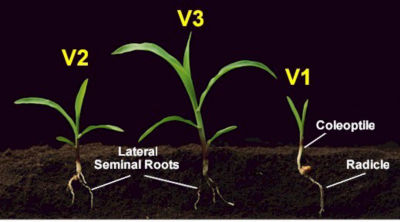Is Early Season Frost a Threat to Your Corn?
May 5, 2020
Q. What should I watch for when frost damage happens in my field?
The sight of frost on an emerged corn field may leave you wondering if your crop has been injured (figure 1) . To answer this, you need to evaluate how low the temperature dropped, and the location of the growing point when the cold weather event occurred. Symptoms of frost injury will start to show up on leaves about 1 to 2 days after a frost, and include a water-soaked appearance, wilting, and a yellow and/or silver discoloration. Several days later, leaves may turn brown and die.
Q. At what growth stage and temperature does frost damage generally kill seedlings?
Death of seedlings is unlikely to occur if the growing point is below the soil surface, or if the temperature remained above 28°F (Figure 2).


Q. How can frost affect the below-ground growing point of a corn seedling?
The growing point of a corn seedling remains below ground until growth stage V6 (6 leaf collars) and is protected from above-ground frost damage, unless the freeze was substantial (Figure 3).1

Q. How crucial is temperature in frost damage?
A temperature at or below 28°F is considered lethal to a corn plant whose growing point is above ground and can injure a growing point that is below ground if the temperature remained this low for more than a few hours. Signs of frost injury may be observed on the leaves of young plants, but if the growing point remains healthy, the plants should make a rapid and complete recovery.2
Q. How important is field scouting?
It is ideal to wait 3 to 5 days after a frost to accurately assess potential plant damage. Scout your field regularly, if new leaves are not emerging, check the growing point for discoloration. A white or cream-colored growing point that is still firm is an indication that the plant is recovering, while growing points that are darkened and soft are likely to die. If weather conditions are conducive for recovery, a new leaf should develop 3 to 4 days after the frost. Occasionally, decaying leaf tissue may inhibit the growth of new leaves from the whorl, giving the corn seedling a twisted appearance.2 In most situations the new growth will grow through the decaying tissue.
Purdue University has more information on the growing point location at different growth stages.
Q. What management options are available for damage from an early frost?
The best thing you can do is to wait 3 to 5 days before making a field-by-field assessment of frost damage.3 At that point, surviving corn plants should have new leaf tissue beginning to expand from the whorls, while dead plants will not.2 Dry, warm conditions will favor recovery, while multiple frost events or cool, damp weather can compromise recovery and plant health. Corn survival is mainly dependent on a healthy growing point and new leaf growth.
Q. What to keep in mind before replanting?
Evaluate your existing crop stand for potential survival and uniformity before deciding to replant. Compare the yield potential of the existing stand with the yield potential of a replanted stand.
Sources
1 Elmore, R.W. 2015. Impact of early season frost (before V4). Iowa State University. https://crops.extension.iastate.edu/corn/production/management/planting/frost.html
2 Nielsen, R. and Christmas, E. 2001. Frost and low temperature injury to corn and soybean. Purdue University. https://www.agry.purdue.edu/ext/corn/news/articles.01/Frost_Corn_Soy-0418.html
3 Nielson, R. 2019. Assessing frost/cold temperature injury to young corn. Purdue University. https://www.agry.purdue.edu/ext/corn/news/timeless/FrostedCorn.html
4013_Q2